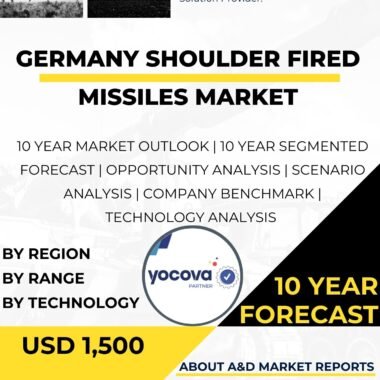Description
The South Korea shoulder-fired missiles market is a significant segment of the country’s defense industry, providing advanced and portable anti-tank and anti-aircraft missile systems. Shoulder-fired missiles, also known as man-portable air-defense systems (MANPADS) or anti-tank guided missiles (ATGMs), are crucial assets for ground forces, providing them with the capability to engage armored vehicles, helicopters, and other aerial threats with precision and mobility. South Korea’s focus on indigenous development, strategic partnerships, and technological innovation has positioned it as a major player in the global shoulder-fired missiles market.
Shoulder-fired missiles play a pivotal role in modern warfare, offering infantry and special forces the ability to effectively engage enemy assets at stand-off distances. These systems are lightweight, compact, and easily deployable, providing ground forces with a significant advantage in asymmetric and conventional conflicts.
Indigenous development has been a cornerstone of South Korea’s defense strategy, and the shoulder-fired missiles market is no exception. The country’s defense industry, represented by companies like LIG Nex1 and Hanwha Defense, has made significant progress in developing advanced shoulder-fired missile systems tailored to meet the specific requirements of the South Korean military.
One of the key indigenous shoulder-fired missiles in South Korea’s inventory is the “Chungung.” The Chungung is an advanced anti-aircraft missile system capable of engaging low-flying aircraft and helicopters. It is highly mobile and designed to be rapidly deployed by infantry units, providing them with air defense capabilities in various operational scenarios.
Beyond domestic requirements, South Korea actively seeks strategic partnerships with international defense and technology companies to enhance its shoulder-fired missile capabilities. Collaborations with global manufacturers enable technology transfer, joint research, and the integration of foreign missile systems into South Korea’s indigenous platforms. These partnerships contribute to the continuous improvement of South Korea’s shoulder-fired missile technology and reinforce its position in the global defense market.
Moreover, South Korea’s commitment to innovation and research and development (R&D) has driven advancements in shoulder-fired missile technology. The country invests in R&D programs to improve missile range, accuracy, and target acquisition capabilities. Technological improvements focus on enhancing guidance systems, incorporating advanced seekers for target tracking, and integrating fire-and-forget capabilities for increased effectiveness.
As part of its broader defense industry, South Korea’s shoulder-fired missiles market extends beyond domestic needs. The country actively exports shoulder-fired missile systems and related technologies to other nations, generating revenue and expanding its influence in the global defense market. Successful exports demonstrate the reliability and performance of South Korean-made missile solutions, contributing to the growth of its defense industry.
To ensure optimal utilization and proficiency in operating shoulder-fired missiles, South Korea places significant emphasis on training and skill development for its military personnel. Training programs focus on familiarizing operators with missile handling, targeting procedures, and effective utilization in various operational scenarios.
Moreover, safety is a paramount consideration in the shoulder-fired missiles market, given the importance of minimizing risks to friendly forces and civilians during missile deployment and engagement. South Korea adheres to stringent safety regulations and missile maintenance standards to ensure the reliability and performance of shoulder-fired missile systems, enhancing their safety and effectiveness on the battlefield.
In conclusion, the South Korea shoulder-fired missiles market is a critical aspect of the country’s defense capabilities. Indigenous development, strategic partnerships, and innovation have allowed South Korea to create advanced shoulder-fired missile systems that meet the specific needs of its military and provide infantry and special forces with a vital capability on the battlefield. From engaging enemy armored vehicles to countering aerial threats, shoulder-fired missiles play a significant role in enhancing South Korea’s military readiness and contributing to regional security. As the defense industry continues to evolve, South Korea’s dedication to advancing its shoulder-fired missile technology will remain essential in maintaining its position as a major player in the global shoulder-fired missiles market.




